Doors Open event at Small Arms on Sept. 28, 2013 will feature an estimated 3,000 attendees
On Aug. 17, 2013, I spoke with Bob Cutmore, a key organizer of the Sept. 28, 2013 Doors Open event at the historic Small Arms Ltd.building in Mississauga.
Mississauga Ward 1 Councillor Jim Tovey has described the Doors Open event at an earlier blog post.
Among other things, I’m looking forward to this year’s Doors Open because I’ll be setting up a table to publicize the May 3 & 4, 2014 Jane’s Walk in Long Branch.
When I spoke with Bob Cutmore, I learned of a new strategy for the sharing of information about the repurposing of the building.
Information from conceptual renderings did not register for most site visitors
At previous Doors Open events, information was shared on conceptual display cards, but in Cutmore’s experience, for most people the conceptual renderings didn’t convey all that much meaning.
The fact that the Doors Open organizing team
(a) thought closely about how visitors to the Small Arms Ltd. building were actually experiencing the displays, and
(b) have subsequently found a way to enhance the quality of the viewer’s experience, inspires me tremendously.
This was one of the chief things that I took away from the interview.
Ronnie the Bren Gun Girl
Through speaking with Cutmore I also learned much more about the displays that I had seen – and hadn’t given that much thought about, at the time – about the Second World War Two icon named Veronica Foster – featured as Ronnie the Bren Gun Girl in wartime propaganda posters.
I’d seen photos of Foster at a previous Doors Open display, but now I know much more about her back story, as I will discuss in a subsequent blog post – which may be some time from now as my current focus is on video and sound editing.
It may be added that attitudes toward smoking underwent a significant shift from the 1960s to the 1980s and beyond. In the 1940s smoking was just an everyday, socially acceptable thing that almost everybody engaged in.
Veronica Foster was in fact a non-smoker; she only smoked for her photo session
I’ve also had the opportunity to learn about the history and specifications of the Bren Gun – produced at a World War Two small arms plant in what is now the Liberty Village neighbourhood of Toronto.
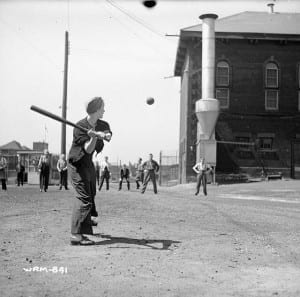
Ronnie the Bren Gun Girl. The site of the photo is in what is now Liberty Village in Toronto. Source: Libraries & Archives Canada
As well, I’ve located some of the online archival photos that document Veronica Foster’s iconic role. After the war, Foster worked as a model and musician. She married a musician. The couple had seven children.
She passed away in 2000, but some of her family will be attending the Sept. 28, 2013 Doors Open event.
An interesting feature of such an iconic figure is that many perspectives are available to us, in the event that we wish to learn more, and reflect upon, the nature and meaning of warfare.
War is work that soldiers – and civilians in the case of small arms workers – do.
A useful reference regarding war as work, aside from what’s been discussed in the Military History category at this website, is Chapter 7 dealing with combat and ideology in the British Army during the Second World War in The World War Two Reader (2004).
A November 10, 2014 article at the CBC The Current website provides more background about Veronica Foster.
[End of update]
Hanlan Feedermain
I also learned that the Tunnel Boring Machine that will be used in the Hanlan Feedermain Project – a key element of the proposed Lakeview Waterfront Connection Project – will be installed right on the Small Arms property.
The Feedermain will be aligned with Dixie Road, on its way to Brampton.
Earlier Doors Open events focused on conceptual renderings
Previous Doors Open events at Small Arms Ltd. have featured conceptual display cards in one of the rooms, providing details about the planned repurposing of the site.
The displays haven’t turned out to be the best possible way to tell the Small Arms story, however, in Bob Cutmore’s experience.
“I’ve done that program several times,” he said, “and I just more and more was thinking to myself, you know, 95 percent of these people just don’t get the renderings.”
This time, “we’ll actually put people in front of the building”
“So I thought, what we’ll do, instead of having renderings of people, we’ll actually put people in the front of the building – the actual artists, displaying, demonstrating, and selling many different art forms – because I want to get the concept across to them: This is going to become an arts and culture and science centre.
“And people cannot just go there to look at art forms; they can actually sign up and learn the different art forms there.”
An edited version of our Aug. 17, 2013 interview continues as follows:
Jaan Pill: Perfect. So it’s going to be an experiential kind of thing. I like that very much.
Could you tell me what you said to me earlier about the demographic that you’re aiming towards, and about the numbers attending, in terms of the overall Doors Open Mississauga?
Bob Cutmore: OK. Yes, we started the Doors Open three years ago. The building is in honour of the women war workers from World War Two.
That was a huge purpose-built facility, built in 1941. And they were building mainly the Enfield rifles and the Sten machine guns there – and they built a lot of them. They were doing a thousand Lee-Enfields a day, and about 250 Sten machine guns.
Of the 5,500 daily work force, almost 70 percent of those were women.
So, in the reuse of the building, the main thing will be to honour those women. So, in the first Doors Open we did, we tuned into the history and heritage of that. And we had men and women come in who actually worked there, and started a registry to get these stories.
And we brought in some re-enactors from the Second World War. We had some background music. We had some photos. We had a guest speaker in, Honorary Colonel Gerald Haddon, who is John A. D. McCurdy’s grandson. McCurdy designed and flew the Silver Dart for the first powered flight in the British Empire, and he was a very good friend of Glen Curtiss.
Long Branch Aerodrome
Bob Cutmore: And, of course, on the adjoining property we had the first Aerodrome in the country. It went up in 1915.
So with the re-enactors and the different displays that we had, we also had some community input from the Region of Peel doing different projects that were around in the city.
So of the forty-three sites open that year, there were 6,500 people; we had 1,133.
Second year
Bob Cutmore: That was the first year. Last year was the second year, and we expanded the existing program that we had and we added additional things – like we had the president of the American Rosie the Riveter Association there. We had more women that worked there.
And, oddly enough, my mother [Olga Cutmore] is the first honorary Canadian member of that organization, because she worked at the Small Arms.
Jaan Pill: Exactly. That’s what Jim Tovey told me.
Bob Cutmore: Yeah. So, during the first year, we had a woman come by and said, you know – took a little bit of offense to the American thing, and she said, you know, “We have the equivalent here, in Ronnie the Bren Gun Girl.” That was a woman who worked at the John Inglis plant on Strachan Avenue, who built the Browning guns and the Bren guns.
And as it turned out, it was her daughter that we were talking to, and we have actually called her several times, to convince her to come down, and we did a big display, with Bren guns there and had blown up pictures. The family was just totally taken back by the interest in this, so we’ll have them back again this year.
Jaan Pill: Wonderful.
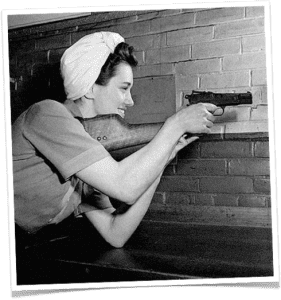
Image from Small Arms website: http://www.smallarms.ca/SmallArms.html. In an online posting of the photo at a website (http://www.pbase.com/mrclark/inglis_factory) dealing with the history of the wartime John Inglis plant in Toronto, the photo is labelled as Inglis Browning High Power.
Bob Cutmore: I do most of the tours and displays for the building and heritage interpretation and we had architectural renderings of the adaptive reuse of the building to an arts, culture, and science centre. But I found that people were just not connecting with what we were trying to do.
And so for the 2013 program, I thought the way to do that is to actually get a variety of different artists, to come to the building, and demonstrate the art, display the art, and sell the art.
But I wanted to display it because I want people to know that once this building is done and converted, they can also then go there, to learn the different art forms. That’s a huge function of it, and of course that opens up an enormous new demographic of people. I mean, it’s much larger than the heritage and historical people that come to the events.
And of course, last year, you know, we brought in the Mark 4 Sherman Tank, which was quite an attention-getter, and as it turns out, of the forty-four venues open last year, attendance jumped to about 7,500, but our attendance went from 1,133 to 2,174.
And so again, you know, our participation, we’ve gone from a sixth of the total participation to like a third – and this year, with the arts and culture, our arts groups in there, we’ll be looking at over 3,000 people.
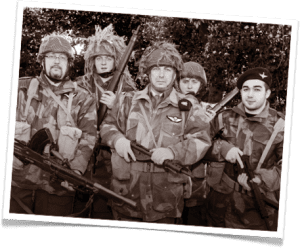
Second World War re-enactors. Image from Small Arms Ltd. website: http://www.smallarms.ca/SmallArms.html
We’ve got an expansion on the re-enactors, on the different equipment. The tank is back. We’ve got at this point about twenty-five confirmed artists – and they will be potters, sculptors, painters, photographers, singers.
Jaan Pill: And are they all from Mississauga? Or can they be from elsewhere as well?
Bob Cutmore: Most of them are from Mississauga, but when I put this together, I wanted to cast a bigger net – so we’ve got people coming in from the Golden Horseshoe, obviously; Toronto and east of Toronto; Hamilton, because I wanted to get that demographic as wide as it could be.
Jaan Pill: Absolutely.
Bob Cutmore: And I think it’s gonna be phenomenal.
Now, that is a designated building. Actually, my brother [Ken] and I wrote the letter, to get it designated. So it has a Class 5, which is a separate building, dedicated to protection through the Ontario Heritage Act.
Jaan Pill: Beautiful. That’s very good to know that it’s already in place.
Bob Cutmore: This is really important stuff, because I was saying to Jim [Tovey], you know, we have to get the people in Toronto to realize that, you know, the [Mississauga-Toronto] border is, is just a few hundred metres away.
The Small Arms building was actually called Small Arms Ltd., Long Branch, Ontario.
Jaan Pill: Exactly.
Bob Cutmore: Because there was no train station in Long Branch, or postal office. So the whole thing was called the Long Branch Ranges. And there’s still quite a few people in that Long Branch, Mimico, New Toronto area that worked there, in different phases of the building, and we’re trying to get that out. Like, I went to high school with Doug Holyday, and he’s now the new Conservative MPP there, and we’d like to get him there, and possibly Mark Grimes.
Jaan Pill: Oh, yeah. That’s great.
Bob Cutmore: We have something easy to sell now, because we’ve got the bragging rights for the numbers. Nobody else is going to come close to that.
Jaan Pill: Absolutely.
Bob Cutmore: And we’re even thinking of possibly adding the Small Arms to Toronto’s Doors Open, which they have over the May 24th weekend.
Jaan Pill: I think that makes a lot of sense. And also, I’ve organized, over the last few years I’ve been involved with Jane’s Walks.
Bob Cutmore: I do the Jane’s Walks here in Lakeview.
Jaan Pill: Oh, you do them!
Bob Cutmore: I do Lakeview East with Councillor Tovey and I do Port Credit East with architect Michael Spaziani.
Jaan Pill: And you do that in May of each year or at other times of the year?
Bob Cutmore: We didn’t do it last year but we do it on the Jane’s Walk weekend.
Jaan Pill: Wonderful. That’s wonderful to know. Because that’s a wonderful way to reach the wider public.
Small Arms Ltd. websites
Bob Cutmore: The one that promotes basically the progress and the events that we do there is www.smallarms.ca. And our other website, which basically covers the historical aspects of the building with photos and links to actual films that were done there for promotion, is at www.arms2arts.ca.
Oral histories
[We discussed the recording of oral histories in recent years associated with the Small Arms Ltd. building.]
Bob Cutmore: I work closely with Matthew Wilkinson. I know him very well. And he’s president of Mississauga Heritage. He’s a good friend of mine who I do heritage walks with him. We’re reinstating heritage walks here sponsored by the business association. Richard Collins is the president of the Mississauga South Historical Society.
I see him almost every day.
Jaan Pill: Wonderful. Jim Tovey spoke with me especially about the Lakeview Waterfront Connection Project. I’m so impressed with his work, because with Lakeview Inspiration, the quality of the communications with the public, and also the public engagement –
Bob Cutmore: That’s another element here, with Jim. I had a meeting with him the other night, and I said to him, and I just sent the email out yesterday: I want to, even though we’ve had some public engagement, I really want to bump that up heavily this year.
Jaan Pill: Beautiful.
Bob Cutmore: So, what we will be having is – the Lakeview Waterfront Connection Project is a joint thing between Toronto & Region Conservation, Credit Valley Conservation, and Region of Peel. So they didn’t have much – they came last year, but this year we have a full PowerPoint presentation and everything. They’re confirmed to be there.
The Region of Peel is coming with a complete overview of the Hanlan Feedermain Project, the one going up Dixie Road.
Jaan Pill: Yes, Jim Tovey is very excited about that and he gave some background, and so I’m very interested in that aspect.
Bob Cutmore: The Tunnel Boring Machine will actually be installed on the Small Arms property, and that’s where it will be retrieved from, because it lines straight up with Dixie Road.

Road construction is currently under way, in connection with the Hanlan Feedermain Project, in front of the Small Arms Ltd. building at Dixie Road and Lakeshore Road East. Jaan Pill photo
We’re also having the two community sessions. There’s Inspiration Lakeview and Inspiration Port Credit. And I’ve also asked Port Credit Marina Parks West and Waterfront Parks Strategy, to be there. And also the Credit River Parks Strategy, which, again, is PowerPoint and and I just reviewed that last month. I’m a citizen member of the Heritage Advisory Committee for the City of Mississauga.
Jaan Pill: Beautiful. That’s additional information. And so the Feedermain, it goes underneath Dixie Road, is that it?
Bob Cutmore: Most of it will be Tunnel Bored straight up Dixie Road to Brampton, and where they can’t Tunnel Bore it, they will surface dig it and encase it.
Jaan Pill: Wonderful.
Bob Cutmore: And there’ll be a couple of sub-lines going East-West on that as well.
Jaan Pill: Well, that’s great. And I really appreciate this information.
Updates
A January 2017 article at the neighbourhoodchange.ca website is entitled: “Liberty Village: The Makeover of Toronto’s King and Dufferin Area.”
The article’s concluding paragraphs read:
The last of the major projects currently transforming the area is the former Inglis factory itself. A building once used to build Bren guns in wartime and washing machines in peacetime is being converted into a retail and commercial indoor mall.
The area’s makeover is supported by newspaper ar- ticles that promote the area as an “artsy loft district,” a “bohemian enclave,” and a “neighbourhood to live, work and play” for people who want to be close to the entertainment district and to the gentrifying Queen Street West area. With the influx of large-scale developers, it is likely that the new developments will obliterate any trace of the “artsy” and “bohemian” residents who once populated the area.
[Conclusion:] The gentrification of the King and Dufferin area can be described as municipally managed. Toronto’s economic development corporation, in combination with Toronto Artscape, started to attract investment and industries to the area during Toronto’s real estate slump of the early 1990s to prepare the area for future rounds of gentrification. Real estate developers started to buy up properties in the King and Dufferin area and initiated the remake of this old-industrial district into a thriving IT and new media cluster, protected from residential intrusion by large-scale development projects through the City’s employment area program.
Since then, the area has developed from a distinctive and diverse artists’ community developed on the margin of Toronto’s mainstream culture and without the help of capital or government, into an increasingly homogenized space that has been made safe, clean, and attractive for capital investment and new residents.
[End]
A Jan. 23, 2018 BBC article is entitled: “Naomi Parker Fraley, the real Rosie the Riveter, dies aged 96.”

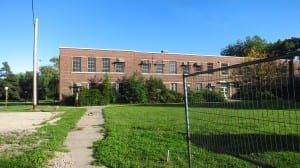
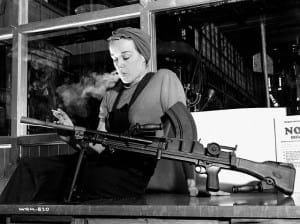
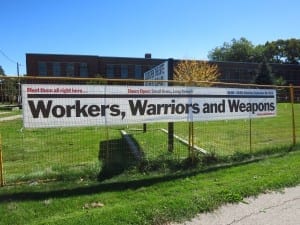


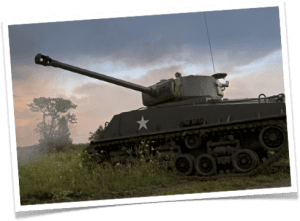
A reference for your interest:
http://vintageinn.wordpress.com/2014/02/03/the-canadian-rosie-the-riveter-veronica-foster/
From the above noted link, we have some fascinating information concerning Veronica Foster, “Ronnie the Bren Gun Girl:
Note from Laura-Veronica’s Daughter:
Just to clarify a small fact… my mother never smoked. The photographer wanted her to smoke because I guess it was considered sexy in those days and smoking was supposed to be the socially acceptable cool in those days. Up until a few years ago you could smoke anywhere you wanted at any time. But… my mother never smoked… just for the “Ronnie” photos.